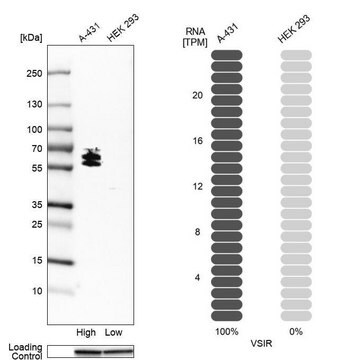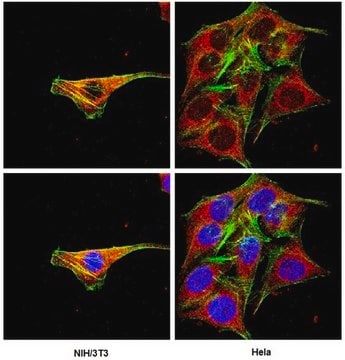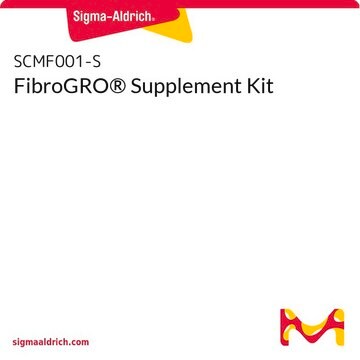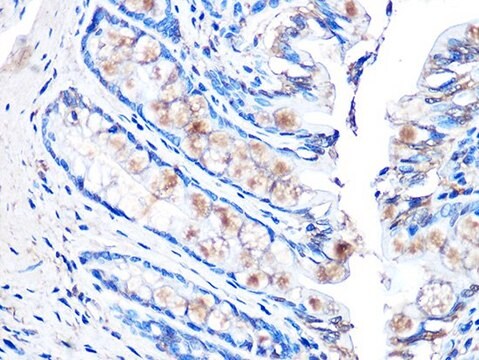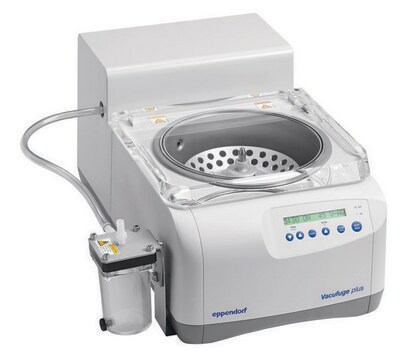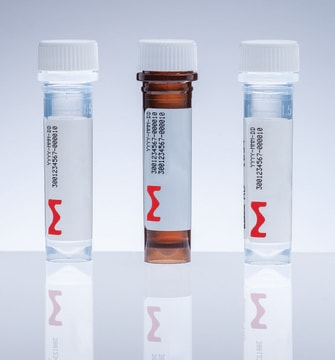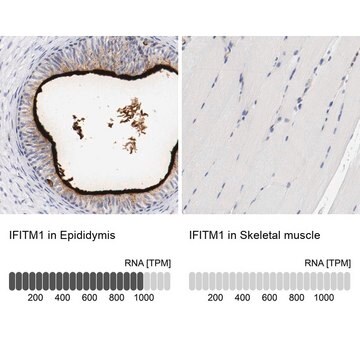推荐产品
生物源
rabbit
品質等級
共軛
unconjugated
抗體表格
affinity isolated antibody
抗體產品種類
primary antibodies
無性繁殖
polyclonal
產品線
Prestige Antibodies® Powered by Atlas Antibodies
形狀
buffered aqueous glycerol solution
物種活性
human
加強驗證
independent
Learn more about Antibody Enhanced Validation
技術
immunofluorescence: 0.25-2 μg/mL
immunohistochemistry: 1:200-1:500
免疫原序列
PPQALRPRDRRRQEEIDYRPDGGAGDADFHYRGQMGPTEQGPYAKTYEGRREILRERDVDLRFQTGNKSPEVLRAFDVPDAEAREHPTVVPSHKSPVLDTKPKE
UniProt登錄號
運輸包裝
wet ice
儲存溫度
−20°C
目標翻譯後修改
unmodified
基因資訊
human ... CLCC1(23155)
正在寻找类似产品? 访问 产品对比指南
一般說明
CLCC1 (chloride channel CLIC like 1) is an intracellular chloride channel, which belongs to the CLIC channel family. This protein is composed of 551 amino acids, and is thought to have four transmembrane domains. Its mRNA is expressed at high levels in testis, and is moderately expressed in brain, heart, lung, kidney, liver and spleen. It localizes to Golgi bodies, nucleus and ER (endoplasmic reticulum), and is related to Mid-1 protein of Saccharomyces cerevisiae. This gene localizes to human chromosome 1.
免疫原
Mid-1-related chloride channel 1 isoform 1 recombinant protein epitope signature tag (PrEST)
應用
All Prestige Antibodies Powered by Atlas Antibodies are developed and validated by the Human Protein Atlas (HPA) project and as a result, are supported by the most extensive characterization in the industry.
The Human Protein Atlas project can be subdivided into three efforts: Human Tissue Atlas, Cancer Atlas, and Human Cell Atlas. The antibodies that have been generated in support of the Tissue and Cancer Atlas projects have been tested by immunohistochemistry against hundreds of normal and disease tissues and through the recent efforts of the Human Cell Atlas project, many have been characterized by immunofluorescence to map the human proteome not only at the tissue level but now at the subcellular level. These images and the collection of this vast data set can be viewed on the Human Protein Atlas (HPA) site by clicking on the Image Gallery link. We also provide Prestige Antibodies® protocols and other useful information.
The Human Protein Atlas project can be subdivided into three efforts: Human Tissue Atlas, Cancer Atlas, and Human Cell Atlas. The antibodies that have been generated in support of the Tissue and Cancer Atlas projects have been tested by immunohistochemistry against hundreds of normal and disease tissues and through the recent efforts of the Human Cell Atlas project, many have been characterized by immunofluorescence to map the human proteome not only at the tissue level but now at the subcellular level. These images and the collection of this vast data set can be viewed on the Human Protein Atlas (HPA) site by clicking on the Image Gallery link. We also provide Prestige Antibodies® protocols and other useful information.
生化/生理作用
CLCC1 (chloride channel CLIC like 1) functions as an anion channel. Inactivation of this protein in ER (endoplasmic reticulum) results in increase of HSP70 (heat shock protein) family member GRP78. This results in the accumulation of ubiquitinated proteins in neurons leading to degeneration. Thus, chloride homeostasis is essential for the proper protein-folding functionality of ER.
特點和優勢
Prestige Antibodies® are highly characterized and extensively validated antibodies with the added benefit of all available characterization data for each target being accessible via the Human Protein Atlas portal linked just below the product name at the top of this page. The uniqueness and low cross-reactivity of the Prestige Antibodies® to other proteins are due to a thorough selection of antigen regions, affinity purification, and stringent selection. Prestige antigen controls are available for every corresponding Prestige Antibody and can be found in the linkage section.
Every Prestige Antibody is tested in the following ways:
Every Prestige Antibody is tested in the following ways:
- IHC tissue array of 44 normal human tissues and 20 of the most common cancer type tissues.
- Protein array of 364 human recombinant protein fragments.
聯結
Corresponding Antigen APREST71867
外觀
Solution in phosphate-buffered saline, pH 7.2, containing 40% glycerol and 0.02% sodium azide
法律資訊
Prestige Antibodies is a registered trademark of Merck KGaA, Darmstadt, Germany
免責聲明
Unless otherwise stated in our catalog or other company documentation accompanying the product(s), our products are intended for research use only and are not to be used for any other purpose, which includes but is not limited to, unauthorized commercial uses, in vitro diagnostic uses, ex vivo or in vivo therapeutic uses or any type of consumption or application to humans or animals.
未找到合适的产品?
试试我们的产品选型工具.
儲存類別代碼
10 - Combustible liquids
水污染物質分類(WGK)
WGK 1
閃點(°F)
Not applicable
閃點(°C)
Not applicable
個人防護裝備
Eyeshields, Gloves, multi-purpose combination respirator cartridge (US)
Marguerite Ryan Irvin et al.
Pharmacogenetics and genomics, 21(12), 798-807 (2011-09-08)
Genetic studies may help explain abnormalities of fat distribution in HIV-infected patients treated with antiretroviral therapy (ARV). Subcutaneous adipose tissue (SAT) volume measured by MRI in the leg, the lower trunk, the upper trunk, and the arm was examined in
Yichang Jia et al.
The Journal of neuroscience : the official journal of the Society for Neuroscience, 35(7), 3001-3009 (2015-02-24)
Folding of transmembrane and secretory proteins occurs in the lumen of the endoplasmic reticulum (ER) before transportation to the cell surface and is monitored by the unfolded protein response (UPR) signaling pathway. The accumulation of unfolded proteins in the ER
Xinhua Li et al.
Annual review of physiology, 64, 609-633 (2002-02-05)
Hepatocytes possess chloride channels at the plasma membrane and in multiple intracellular compartments. These channels are required for cell volume regulation and acidification of intracellular organelles. Evidence also supports a role of chloride channels in modulation of apoptosis and cell
M Nagasawa et al.
The Journal of biological chemistry, 276(23), 20413-20418 (2001-03-30)
MID-1 is a Saccharomyces cerevisiae gene encoding a stretch-activated channel. Using MID-1 as a molecular probe, we isolated rat cDNA encoding a protein with four putative transmembrane domains. This gene encoded a protein of 541 amino acids. We also cloned
我们的科学家团队拥有各种研究领域经验,包括生命科学、材料科学、化学合成、色谱、分析及许多其他领域.
联系技术服务部门

